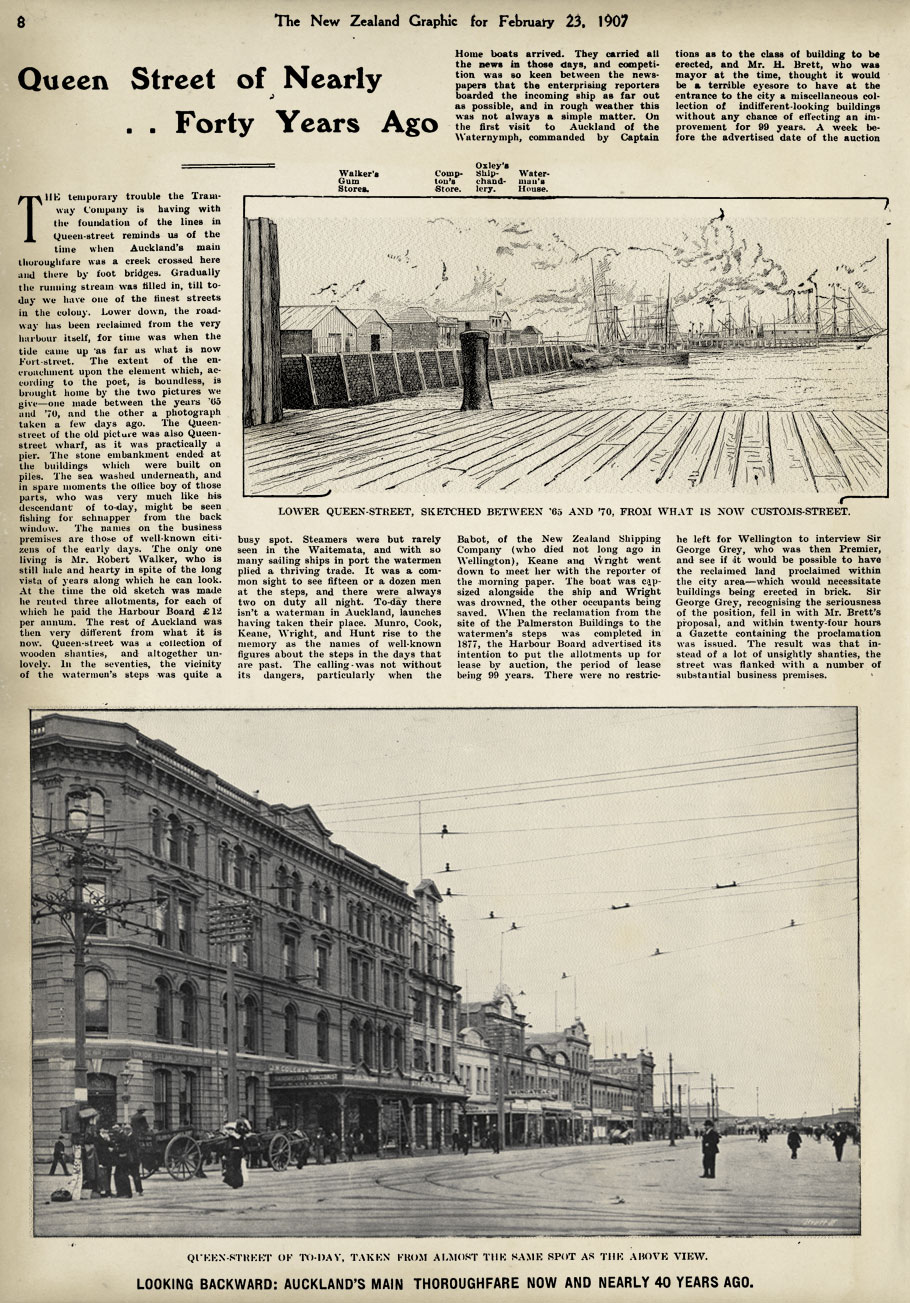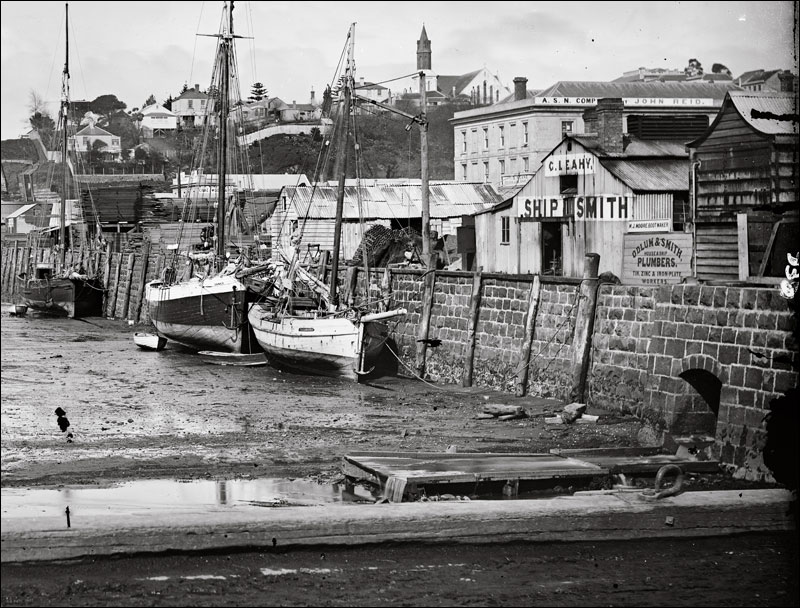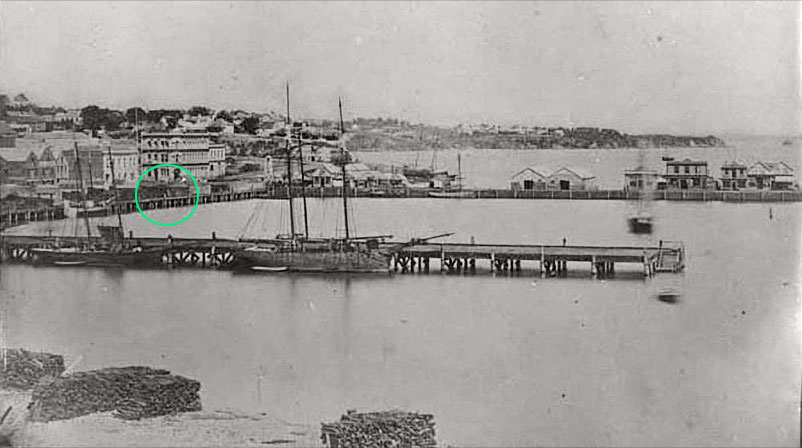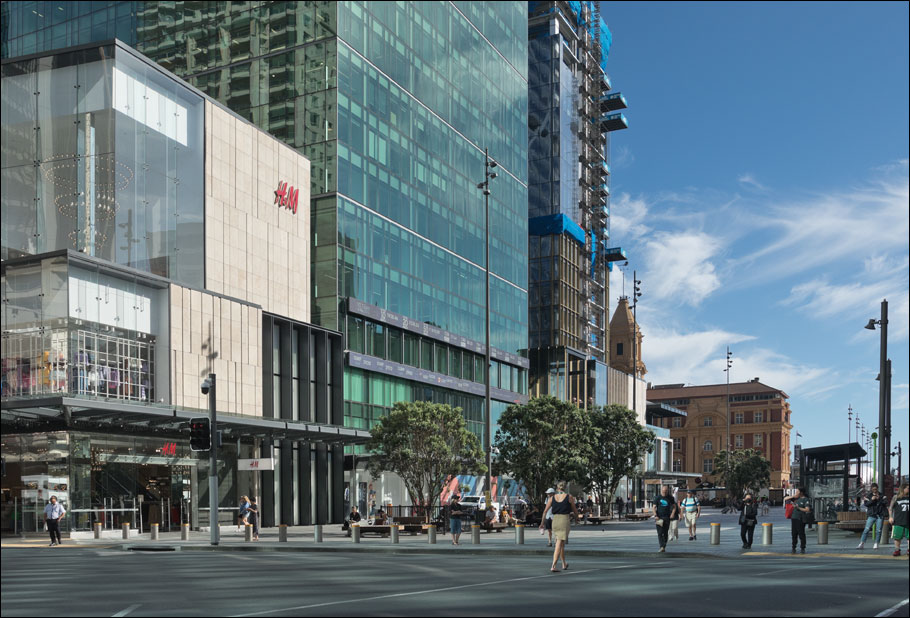Then and Now, Then
Customs Street and Lower Queen Street | 1860s – 1907 – 2023
In its issue of 23 February 1907 the periodical The New Zealand Graphic published the page shown below, a then-and-now treatment of the old waterfront using an 1860s sketch and a 1907 photograph. (See the foot of this page for a version of the text at a larger font size.)

Adapted from the digitised version on the National Library's Papers Past site: https://paperspast.natlib.govt.nz/periodicals/new-zealand-graphic/1907/02/23/8.
A little research has revealed that the 1860s sketch was based on a photograph (see below). Whoever it was at the Graphic who had the bright idea for this page must have either been unaware of the existence of the photo, or, for whatever reason, chose to use the sketch instead. The writer gives a date of from 1865 to 1870 for the sketch/photograph.
The 1907 view is seen from a location near the south-eastern corner of Queen and Customs Streets; the 1860s picture was made from a spot on the other side of Customs Street, more or less by the sea wall, and farther east (before the area to the north was reclaimed in the period 1879-1886).
Looking north from Customs Street East
1865-1870 (unknown photographer) – 2023
Click on image to toggle transition between two photographs


1860s image: unknown photographer | Auckland Libraries Heritage Collections 1043-094 (S.G.Frith Collection)
With so little to go on, the modern view is no more than a semi-educated guess. It shows a private laneway connecting Customs Street East to Galway Street. Below: A view from Queen Street Wharf looking back toward this area. This is a detail from a Burton Brothers image made in the 1870s, presumably some years after the image above (a then-and-now treatment is on this site here).

Below: in this 1870s picture, made from Point Britomart, the buildings on the wharf are recognizable, and little changed when compared to the 1860s image. The green circle indicates the section of Customs Street East where I suppose the 1860s photographer must have been positioned.

Auckland Libraries Heritage Collections
The 1907 scene
Looking north across Customs Street toward Lower Queen Street
1907 (The New Zealand Graphic) – 2023
Click on image to toggle transition between two photographs


1907 image: unidentified photographer | Auckland Libraries Heritage Collections NZG-19070223-0008-02
Click here for a fullscreen version of this transition.
Below: the text from the New Zealand Graphic article:
Queen Street of Nearly . . Forty Years Ago
The temporary trouble the Tramway Company is having with the foundation of the lines in Queen-street reminds us of the time when Auckland’s main thoroughfare was a creek crossed here and there by foot bridges. Gradually the running stream was filled in, till today we have one of the finest streets in the colony. Lower down, the roadway has been reclaimed from the very harbour itself, for time was when the tide came up as far as what is now Fort-street. The extent of the encroachment upon the element which, according to the poet, is boundless, is brought home by the two pictures we give–one made between the years 65 and ’7O, and the other a photograph taken a few days ago. The Queen-street of the old picture was also Queen-street wharf, as it was practically a pier. The stone embankment ended at the buildings which were built on piles. The sea washed underneath, and in spare moments the office boy of those parts, who was very much like his descendant of to-day, might be seen fishing for schnapper from the back window. The names on the business premises are those of well-known citizens of the early days. The only one living is Mr. Robert Walker, who is still hale and hearty in spite of the long vista of years along which he can look. At the time the old sketch was made he rented three allotments, for each of which he paid the Harbour Board £ 12 per annum. The rest of Auckland was then very different from what it is now. Queen-street was a collection of wooden shanties, and altogether unlovely. In the seventies, the vicinity of the watermen’s steps was quite a busy spot. Steamers were but rarely seen in the Waitemata, and with so many sailing ships in port the watermen plied a thriving trade. It was a common sight to see fifteen or a dozen men at the steps, and there were always two on duty all night. To-day there isn’t a waterman in Auckland, launches having taken their place. Munro, Cook, Keane, Wright, and Hunt rise to the memory as the names of well-known figures about the steps in the days that are past. The calling-was not without its dangers, particularly when the Home boats arrived. They carried all the news in those days, and competition was so keen between the newspapers that the enterprising reporters boarded the incoming ship as far out as possible, and in rough weather this was not always a simple matter. On the first visit to Auckland of the Waternymph, commanded by Captain Babot, of the New Zealand Shipping Company (who died not long ago in Wellington), Keane and Wright went down to meet her with the reporter of the morning paper. The boat was capsized alongside the ship and Wright was drowned, the other occupants being saved. When the reclamation from the site of the Palmerston Buildings to the watermen’s steps was completed in 1877, the Harbour Board advertised its intention to put the allotments up for lease by auction, the period of lease being 99 years. There were no restrictions as to the class of building to be erected, and Mr. H. Brett, who was mayor at the time, thought it would be a terrible eyesore to have at the entrance to the city a miscellaneous collection of indifferent-looking buildings without any chance of effecting an improvement for 99 years. A week before the advertised date of the auction he left for Wellington to interview Sir George Grey, who was then Premier, and see if it would be possible to have the reclaimed land proclaimed within the city area–which would necessitate buildings being erected in brick. Sir George Grey, recognising the seriousness of the position, fell in with Mr. Brett’s proposal, and within twenty-four hours a Gazette containing the proclamation was issued. The result was that instead of a lot of unsightly shanties, the street was flanked with a number of substantial business premises.